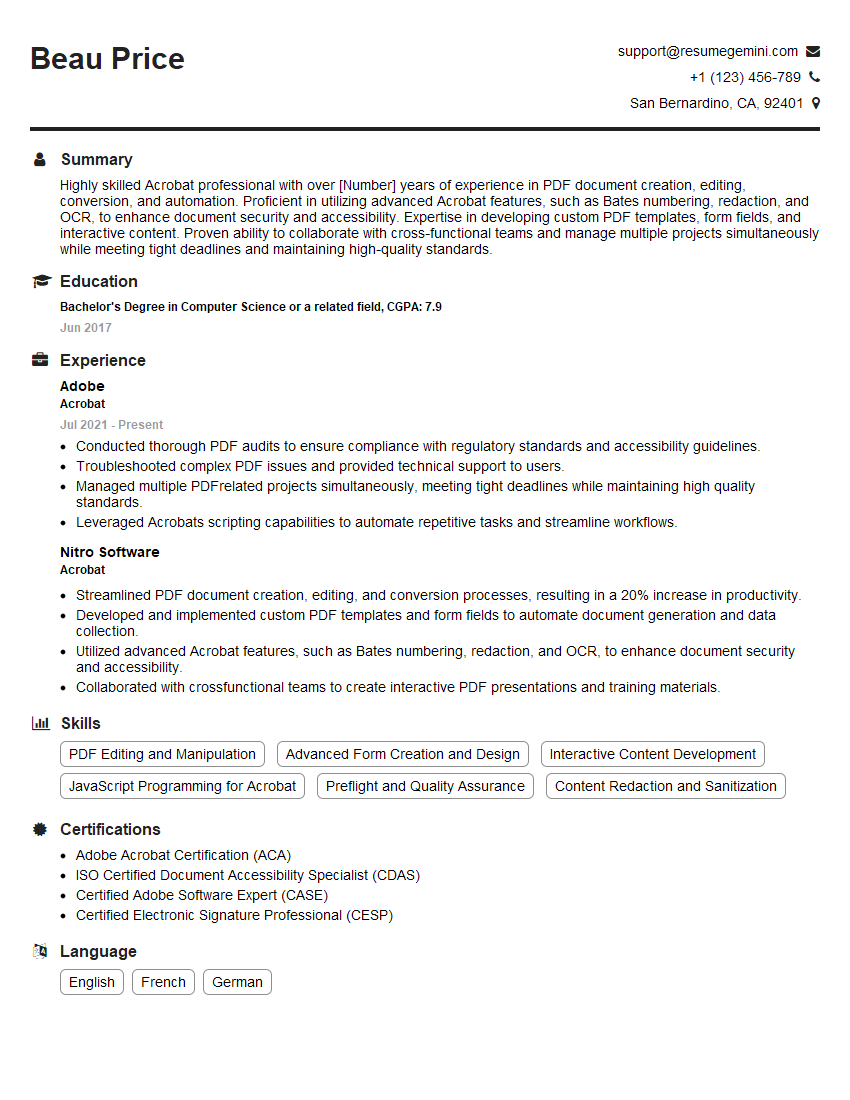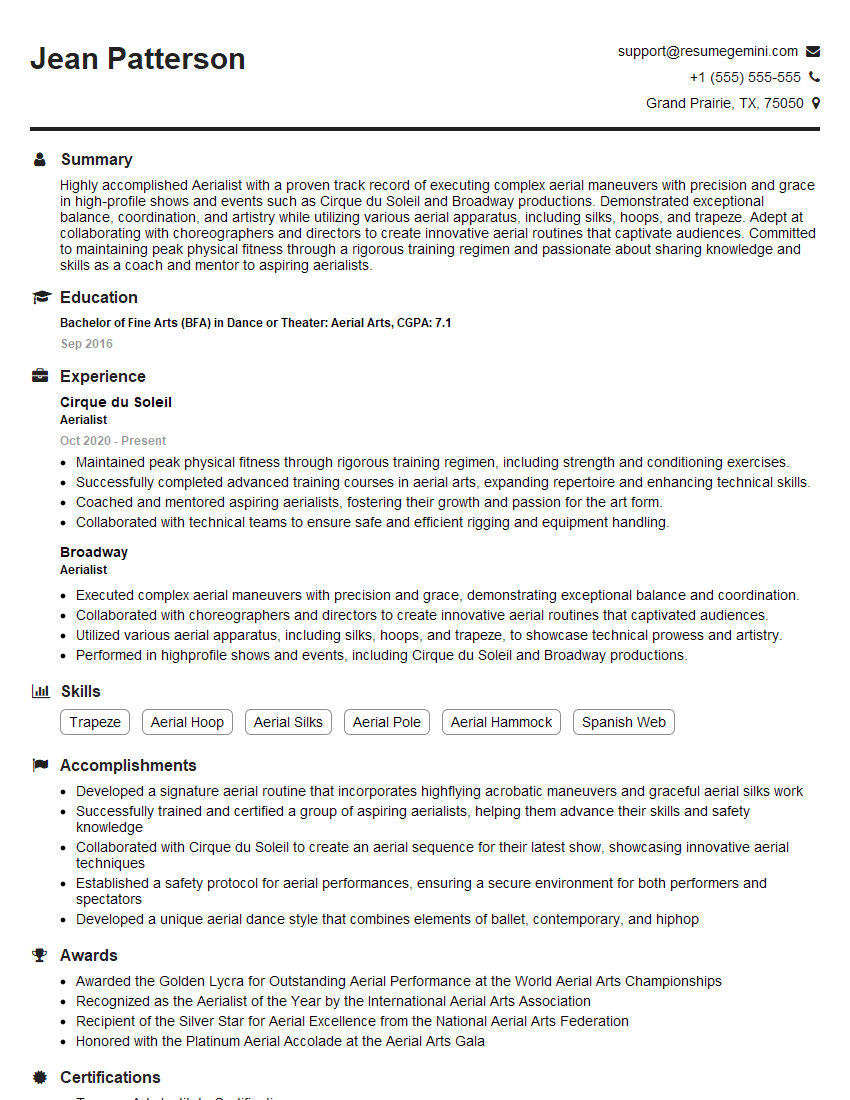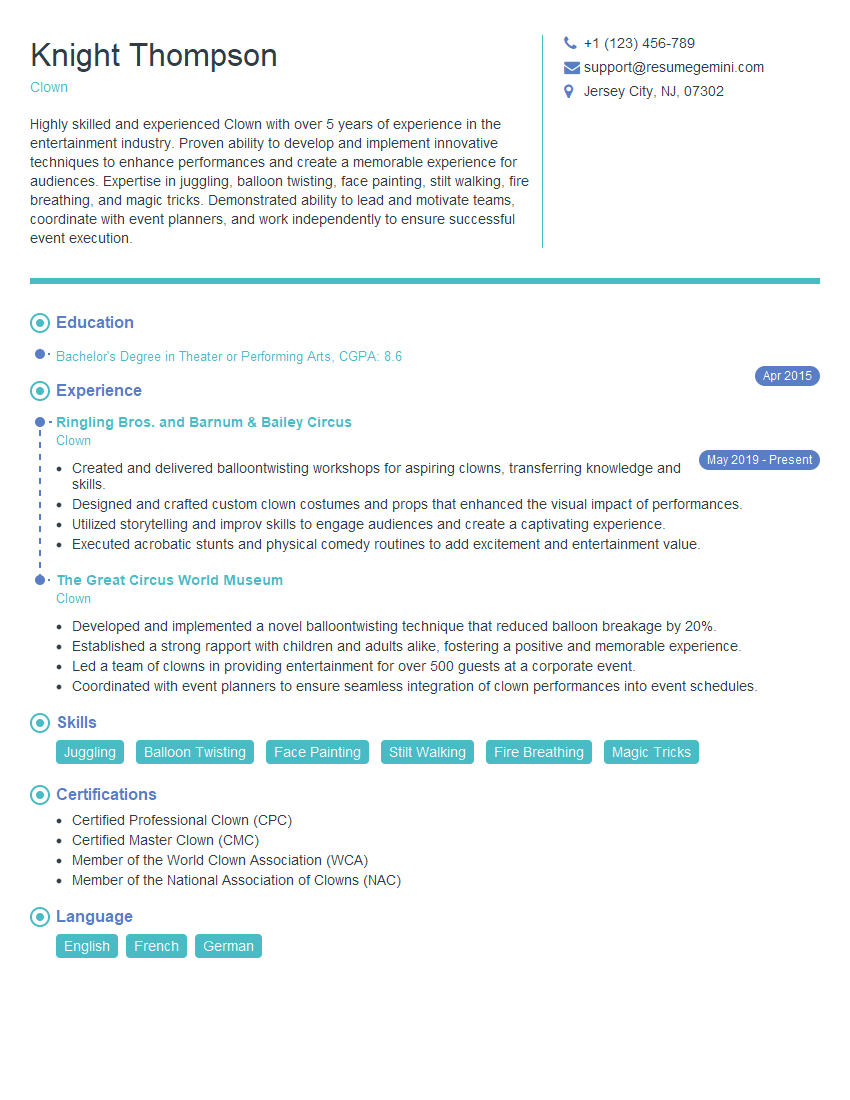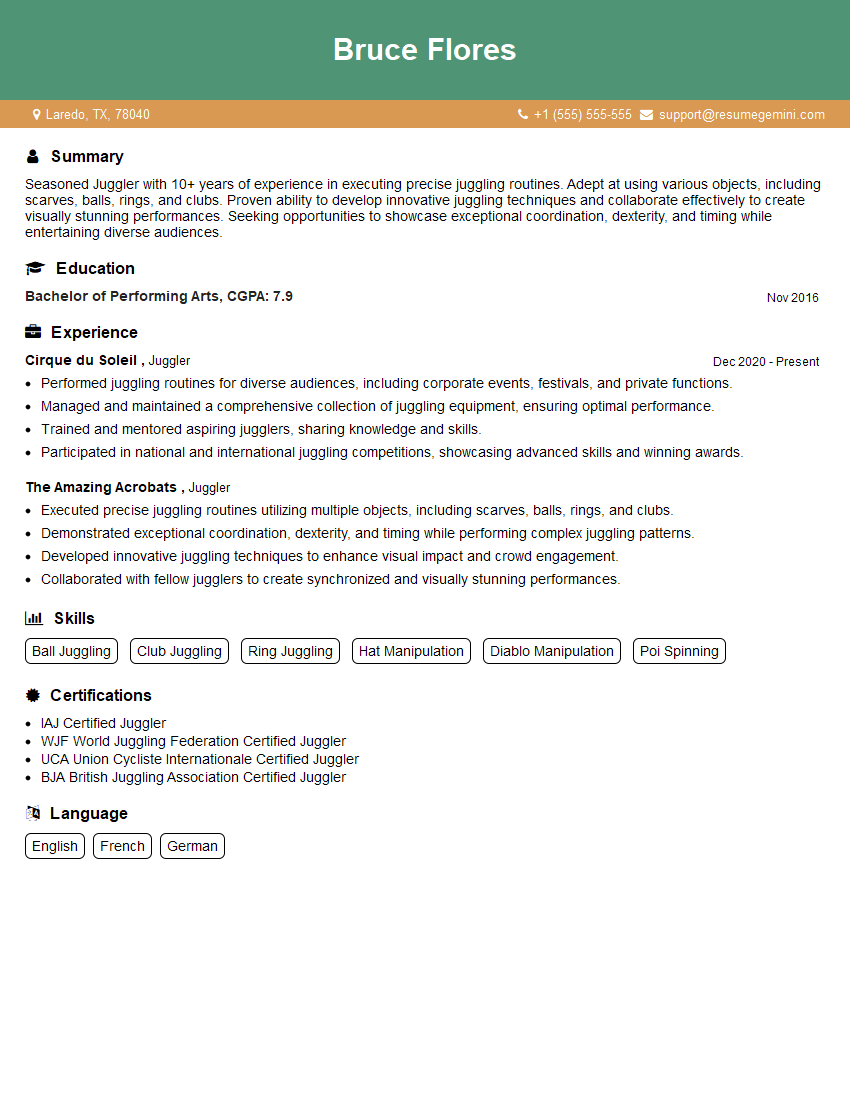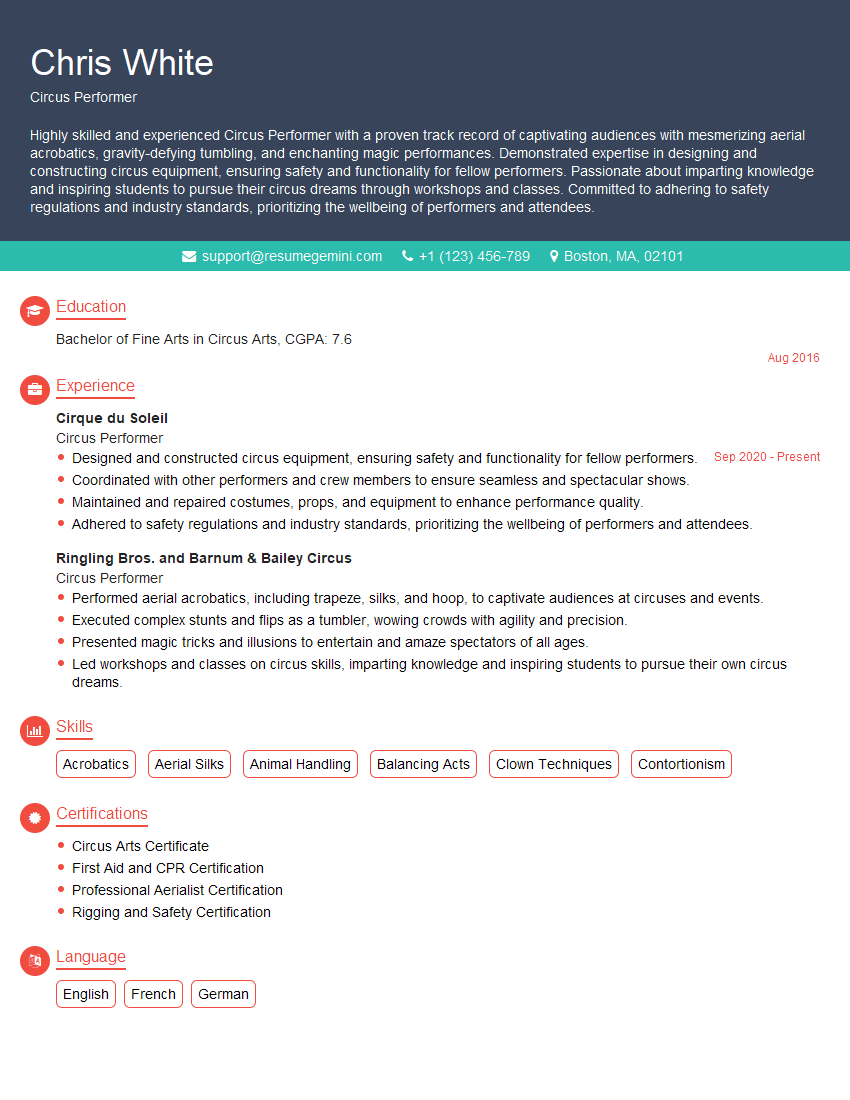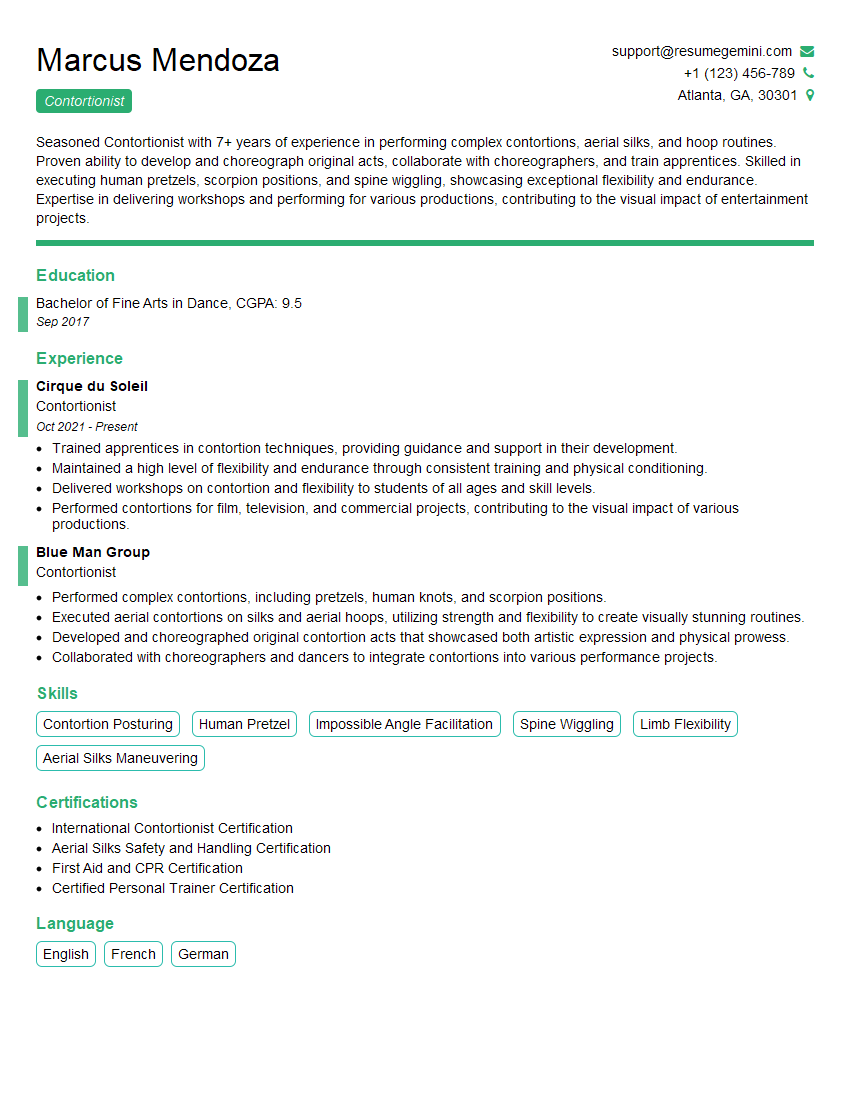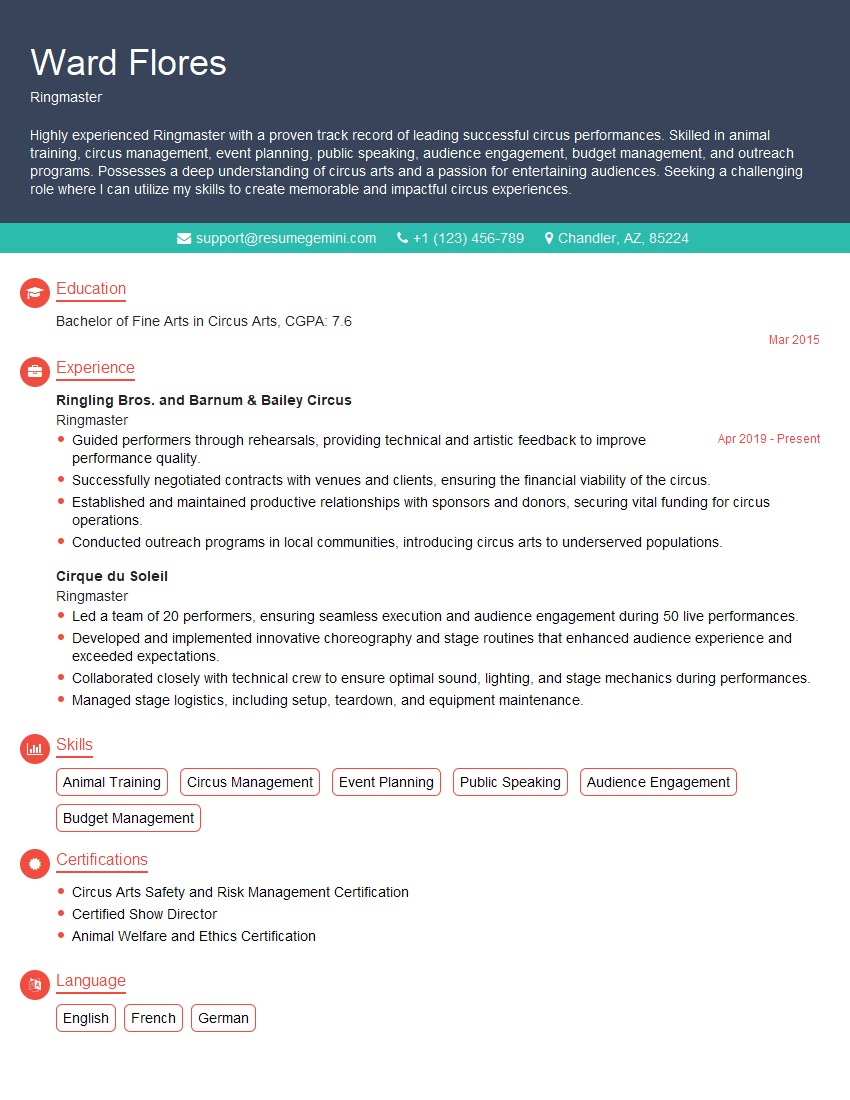Unlock your full potential by mastering the most common Circus Skills interview questions. This blog offers a deep dive into the critical topics, ensuring you’re not only prepared to answer but to excel. With these insights, you’ll approach your interview with clarity and confidence.
Questions Asked in Circus Skills Interview
Q 1. Describe your experience with different aerial apparatuses (e.g., silks, trapeze, lyra).
My aerial apparatus experience is quite extensive. I’ve dedicated years to mastering various disciplines. With silks, I’ve progressed from basic climbs and drops to intricate wraps, inversions, and dynamic transitions, incorporating elements of both strength and grace. My trapeze work includes both flying trapeze, emphasizing the precision and timing of catches and releases, and static trapeze, focusing on strength, balance, and complex poses. Finally, my lyra (aerial hoop) skills encompass spins, drops, and a variety of handstands and poses, demanding significant core strength and control.
- Silks: I’m comfortable with advanced techniques like the ‘shoulder mount’ and creating fluid transitions between poses.
- Trapeze: I’ve performed both solo and duo acts, showcasing both strength and dynamic movements.
- Lyra: I specialize in incorporating dynamic spins and complex transitions into my routines.
Q 2. Explain your approach to spotting and safety procedures during acrobatic performances.
Spotting and safety are paramount. My approach involves a multi-layered strategy beginning with meticulous risk assessment. Before any practice or performance, we carefully analyze potential hazards and implement appropriate mitigation strategies. During rehearsals, we use a dedicated spotter for high-risk maneuvers. The spotter is trained to anticipate potential falls and provide support, always ensuring they maintain safe distance to avoid hindering the performer’s movements but close enough to provide needed support.
For performances, we use a combination of spotters (if necessary), safety nets (where feasible and appropriate), and mats to cushion potential falls. We also implement a comprehensive communication system between performers to ensure everyone is aware of their position and actions. Pre-performance checks of all equipment are mandatory. We consider factors like weather, audience proximity, and the stage setup when determining appropriate safety measures.
Q 3. What techniques do you use to maintain balance and coordination while performing on a tightrope or unicycle?
Maintaining balance on a tightrope or unicycle relies on a combination of physical and mental techniques. On a tightrope, a low center of gravity, steady gaze at a distant point, and controlled, small movements are essential. It’s about cultivating a sense of equilibrium through subtle adjustments of body weight and posture, almost like a constant calibration.
For unicycling, it’s about mastering the art of constant pedaling and subtle shifts in weight to maintain momentum and balance. The key is consistency and practice. Imagine a pendulum; consistent motion helps to keep it in the center. I use similar principles, using continuous, rhythmic movements to counteract any disruption to my balance. Practicing on increasingly challenging terrain helps build resilience and adaptability.
Q 4. How do you incorporate storytelling or character development into your circus acts?
Storytelling and character development are key to creating engaging circus acts. Instead of just showcasing technical skills, we aim to connect emotionally with the audience. For example, in a silks routine, I might portray a character trapped in a web, fighting for freedom, using the silks to represent both confinement and escape. The choreography, the music, and the costuming all work together to weave this narrative. The character’s journey is reflected in the evolving complexity and emotion of the act.
Another example could be a clown act, where carefully developed comedic timing and interactions enhance the visual appeal of the juggling or acrobatics. The character’s personality shapes every aspect of the performance, adding an element of charm and relatability.
Q 5. Describe your experience with juggling different objects and the techniques you employ.
My juggling experience encompasses various objects, from classic balls and clubs to more challenging items like rings and diabolos. The core techniques involve mastering throws, catches, and patterns. With balls, the focus is on achieving consistent throws, using a rhythm and hand-eye coordination, keeping the objects in a specific pattern. Clubs require more wrist action and a wider throwing arc, which challenges hand-eye coordination and wrist strength. Rings add another layer of complexity due to their movement.
I employ different counting systems and visualization techniques to practice and perform complex patterns. These techniques help me anticipate the position of each object and ensure smooth transitions between throws. It is a constant pursuit of refinement of technique and the incorporation of new patterns.
Q 6. What are the common injuries associated with your specific circus discipline, and how do you mitigate risk?
Circus disciplines carry inherent risks. Common injuries in my areas of expertise include sprains, strains, bruises, and, in more severe cases, fractures and concussions. For aerial work, falls are a major concern. To mitigate risk, we prioritize proper training, ensuring a strong foundation of strength and flexibility before attempting advanced maneuvers. We emphasize consistent and proper warm-ups and cool-downs.
Risk mitigation also involves regular equipment checks, using appropriate safety gear, and employing spotters during practice and rehearsal. Furthermore, listening to our bodies is critical; if something feels wrong, we stop. Professional medical attention is sought if any injury occurs. We maintain an understanding that safety is a continuous process, not a one-time event.
Q 7. How do you adapt your performance to different venues and audiences?
Adapting to different venues and audiences involves careful consideration of several factors. The size and configuration of the venue impact the scale and choreography of the act. A large arena requires larger, bolder movements, while a smaller, intimate setting allows for more nuanced interactions with the audience. I tailor the length of the performance, music, and even the style of interaction based on the audience’s anticipated age and demographics.
For example, a children’s show will feature more playful and engaging elements, while a more mature audience might appreciate a more complex and artistic performance. The lighting and sound systems also influence the presentation; I work with the technical crew to ensure the act is well-lit and the sound is appropriate for the setting and the overall performance.
Q 8. Explain your understanding of center of gravity and its importance in acrobatics.
Center of gravity (COG) is the point where the entire weight of an object or body is concentrated. In acrobatics, understanding and controlling your COG is paramount for balance, stability, and executing complex movements. Imagine it as the invisible point your entire body weight balances upon.
Think of a tightrope walker: they constantly adjust their COG by shifting their weight subtly, maintaining a near-perfect equilibrium. In a handstand, a perfectly aligned COG directly above the hands ensures stability. Conversely, a misaligned COG leads to instability and potential falls.
In partner acrobatics, understanding each performer’s COG is crucial for safe and successful lifts and throws. The base needs to properly support the weight of the flyer by positioning themselves to accommodate the flyer’s COG. This involves meticulous positioning and controlled movements to avoid any imbalance that could result in injury.
Q 9. How do you maintain physical fitness and conditioning for your circus skills?
Maintaining peak physical condition is essential for a circus artist. My fitness regime is a holistic approach focusing on strength, flexibility, endurance, and injury prevention.
- Strength Training: I incorporate weight training, bodyweight exercises (calisthenics), and resistance band workouts to build strength in key muscle groups used in acrobatics, such as core, legs, and upper body. This ensures I can safely perform challenging moves.
- Flexibility & Mobility: Daily stretching and yoga are crucial for maintaining suppleness and range of motion, significantly reducing the risk of injuries. This is particularly important for activities requiring high flexibility, such as contortion or aerial silks.
- Cardiovascular Fitness: Regular cardio, including running, cycling, or swimming, improves endurance, stamina, and overall cardiovascular health, which is critical for maintaining energy levels during long rehearsals and performances.
- Injury Prevention: I prioritize proper warm-ups and cool-downs before and after every training session. I regularly consult with physiotherapists and sports massage therapists to address any potential muscle imbalances or tightness.
Q 10. Describe your experience working with other performers in a collaborative environment.
Collaboration is the heartbeat of circus arts. My experience working with other performers has been incredibly rewarding. Successful acts rely on complete trust, clear communication, and a shared understanding of the choreography and risks involved.
For instance, in a partner hand-to-hand act, the level of trust between the base and the flyer is paramount. We spend significant time rehearsing, building rapport, and constantly communicating subtle adjustments and cues during the performance. We are each responsible for the other’s safety and success. A missed cue or a moment of hesitation can have serious consequences. Therefore, our collaborative communication is as crucial as the technical skills themselves.
Working in a troupe environment also fosters a sense of camaraderie and support. We encourage each other, provide constructive criticism, and celebrate each other’s successes. This collaborative spirit strengthens the overall quality and performance of the entire show.
Q 11. Explain your knowledge of different circus styles and traditions.
Circus arts encompass a rich tapestry of styles and traditions, each with its unique character and techniques.
- Classical Circus: This style, with its roots in European traditions, often features acts like clowning, juggling, acrobatics, and animal acts (though ethical considerations increasingly limit the use of animals).
- Contemporary Circus: This style blends traditional circus skills with modern artistic expression. It often incorporates elements of dance, theatre, and multimedia, pushing the boundaries of what’s considered ‘circus.’
- New Circus: This evolving style emphasizes storytelling, thematic cohesion, and character development within the circus arts. It often features acrobatic acts intertwined with narratives and thematic elements.
- Specific traditions: Different countries and cultures have their unique circus traditions, for example, Chinese acrobatic traditions are known for their incredible strength and flexibility, while Russian circus traditions excel in spectacular aerial work.
My training has exposed me to several of these styles, allowing me to appreciate the diversity and artistry within the broader realm of circus performance.
Q 12. What are your strategies for overcoming performance anxiety?
Performance anxiety is a common challenge for performers. My strategies for managing it involve a combination of mental and physical techniques.
- Preparation and Rehearsal: Thorough rehearsal helps build confidence and familiarity with the routine. Knowing the act inside and out significantly reduces anxiety.
- Mindfulness and Meditation: Practicing mindfulness and meditation techniques helps me center myself and calm my nerves before a performance.
- Visualization: Visualizing a successful performance helps build mental resilience and positive expectations. I mentally rehearse the routine multiple times, focusing on my breathing and movements.
- Positive Self-Talk: Replacing negative thoughts with positive affirmations can significantly boost confidence and reduce anxiety.
- Physical Warm-up: Engaging in a proper physical warm-up not only prepares my body for the performance but also helps to alleviate some physical tension associated with anxiety.
It’s important to remember that a degree of nervous energy is normal and can even be beneficial as it can heighten focus and performance. The key is to manage it effectively.
Q 13. How do you handle unexpected events or technical difficulties during a performance?
Unexpected events are an inherent part of live performance. My approach to handling technical difficulties or unforeseen circumstances centers around preparedness, adaptability, and teamwork.
Firstly, we have thorough pre-show checks of equipment and props. Secondly, I have developed backup plans and strategies for common problems, such as a prop malfunction or a costume tear. For instance, in aerial acts, we have safety nets and backup harnesses. We also rehearse emergency procedures so the team can respond efficiently to unexpected events.
Thirdly, clear communication within the team is essential. If something goes wrong, we have pre-arranged signals and procedures to help us react and recover gracefully. Our response is primarily focused on safety and minimizing disruption to the performance. Often, a minor mishap can be seamlessly incorporated into the act with improvisation and quick thinking.
Q 14. Describe your experience with costume and prop design and maintenance.
Costume and prop design and maintenance are vital aspects of a successful circus performance. I have a strong understanding of both the artistic and practical considerations involved.
In terms of design, costumes need to be both visually striking and functional. They must allow for freedom of movement and not pose any safety risks during the performance. Props require careful design to ensure safety, durability, and integration with the act. A well-designed prop complements and enhances the performance without hindering or distracting from the main act.
Maintenance is equally crucial. Regular inspections of costumes and props are necessary to identify any wear and tear or potential hazards. Regular cleaning and repairs are crucial for ensuring their longevity and maintaining a high standard of professionalism. Understanding the materials and construction techniques allows for effective repairs and maintenance. For example, knowing how to sew a rip in a costume or replace a broken part on a prop can save time and prevent delays or accidents during a show.
Q 15. How do you ensure the safety and well-being of yourself and others during rehearsals and performances?
Safety is paramount in circus arts. It’s not just about avoiding injury; it’s about fostering a culture of trust and responsibility. My approach is multifaceted and begins long before a rehearsal or performance.
- Rigorous Warm-up and Conditioning: Every session starts with a comprehensive warm-up tailored to the specific acts we’ll be working on. This prepares our bodies physically and mentally, reducing the risk of strains and tears.
- Spotting and Safety Nets: For acts involving heights or complex partnering, we utilize trained spotters. Safety nets are also employed where appropriate, providing an extra layer of security. The placement and functionality of safety nets are meticulously checked before each use.
- Risk Assessment and Mitigation: Before any new trick or routine is introduced, we conduct a thorough risk assessment. This involves identifying potential hazards, evaluating their severity, and implementing strategies to minimize or eliminate them. For instance, if a particular move has a high risk of falling, we’ll start with simpler variations and gradually increase the difficulty as confidence and skill develop.
- Regular Equipment Checks: All equipment, from ropes and trapezes to silks and balancing apparatus, is regularly inspected for wear and tear. We adhere to strict maintenance schedules and replace equipment as needed to ensure its structural integrity.
- Communication and Teamwork: Open communication is key. During rehearsals and performances, we maintain constant verbal communication, providing cues and confirmations to ensure everyone is synchronized and aware of their surroundings.
For example, during a hand-to-hand act, clear verbal cues are crucial. A missed cue could lead to a fall. Our team practices these cues repeatedly until they are ingrained, ensuring smooth and safe execution.
Career Expert Tips:
- Ace those interviews! Prepare effectively by reviewing the Top 50 Most Common Interview Questions on ResumeGemini.
- Navigate your job search with confidence! Explore a wide range of Career Tips on ResumeGemini. Learn about common challenges and recommendations to overcome them.
- Craft the perfect resume! Master the Art of Resume Writing with ResumeGemini’s guide. Showcase your unique qualifications and achievements effectively.
- Don’t miss out on holiday savings! Build your dream resume with ResumeGemini’s ATS optimized templates.
Q 16. Explain your proficiency in various circus techniques, e.g., hand-to-hand, partner acrobatics.
My circus skills encompass a wide range of techniques, each demanding dedicated training and precision.
- Hand-to-Hand Acrobatics: I’m proficient in various hand-to-hand balances and transitions, ranging from simple base-to-top movements to complex throws and catches. This involves a deep understanding of weight distribution, body mechanics, and unwavering trust between partners.
- Partner Acrobatics: Partner acrobatics requires exceptional strength, flexibility, and coordination. I’m experienced in various forms, including acro-balance (static balances), acro-yoga (partner yoga-based poses), and dynamic partner acrobatics (throws and catches). This requires a strong understanding of center of gravity and impeccable timing.
- Aerial Silks: I’m skilled in aerial silks, utilizing the fabric for various climbs, drops, and intricate poses. This demands both upper body strength and an acute sense of body awareness to control momentum and prevent uncontrolled swings.
- Juggling: I’m a skilled juggler, able to manipulate multiple objects (balls, clubs, rings) simultaneously. This requires hand-eye coordination, precision timing and dexterity.
My proficiency isn’t just about executing the techniques; it’s about understanding the biomechanics, the physics involved, and the art of seamless transitions between movements. I’m always refining my skills and expanding my repertoire.
Q 17. How do you develop and refine your circus acts over time?
Developing and refining circus acts is an iterative process involving constant experimentation, feedback, and refinement. It’s a journey of continuous learning.
- Conceptualization and Choreography: The initial phase involves brainstorming ideas, creating a concept, and developing a basic choreography. This might involve sketching out movements, experimenting with different combinations, and using video recording to analyze progress.
- Rehearsal and Refinement: Rehearsals are crucial for perfecting the technical aspects and developing the artistic expression. We identify areas that need improvement and work on precision, flow, and overall aesthetic appeal. This includes refining transitions, enhancing the visual impact, and ensuring the act has a cohesive narrative.
- Feedback and Collaboration: We actively seek feedback from coaches, fellow performers, and even audience members during test performances. Constructive criticism is essential for identifying blind spots and making objective improvements. Collaboration is key, with each member contributing their skills and ideas.
- Innovation and Experimentation: We constantly strive to innovate, experimenting with new techniques, incorporating different styles, and finding ways to push boundaries. This could involve learning new skills, adapting existing techniques, or finding creative solutions to overcome challenges.
For example, a particular acrobatic sequence might initially appear clunky or disjointed. Through repeated rehearsals and careful attention to detail, we can smooth out the transitions, enhance the flow, and ultimately create a visually stunning and technically proficient movement.
Q 18. What is your experience with stage lighting and sound effects in relation to circus performances?
Understanding stage lighting and sound effects is vital for enhancing the dramatic impact of a circus performance. They are not mere additions; they are integral components of the artistic expression.
- Lighting Design: I collaborate with lighting designers to ensure that the lighting complements the act, highlighting key moments and enhancing the visual storytelling. The use of color, intensity, and movement can significantly impact the mood and atmosphere, creating a dramatic effect.
- Sound Design: Similarly, I work closely with sound designers to create a soundscape that enhances the emotional impact of the performance. Music, sound effects, and even audience interaction can be strategically incorporated to amplify the overall experience.
- Technical Rehearsals: Before a performance, we conduct technical rehearsals to ensure seamless integration of lighting, sound, and the circus act. This involves testing different lighting cues, adjusting sound levels, and coordinating the timing to ensure a harmonious presentation.
- Cueing and Synchronization: Precise timing and synchronization are crucial. The performers must respond accurately to lighting and sound cues to ensure that the act unfolds as intended. We practice this repeatedly to achieve flawless execution.
For instance, a dramatic spotlight could emphasize a particularly challenging acrobatic feat, while a sudden change in music might indicate a shift in the narrative of the act. The collaboration between the performers and the technical team is paramount.
Q 19. What are your skills in crowd interaction and engagement?
Crowd interaction and engagement are crucial for creating an unforgettable circus experience. It’s about connecting with the audience on a personal level and making them feel part of the show.
- Non-Verbal Communication: Eye contact, smiles, and gestures are powerful tools for connecting with the audience. We engage the crowd through subtle expressions and physical cues, creating a sense of intimacy and shared excitement.
- Verbal Interaction: Depending on the act, incorporating verbal interaction can enhance the audience’s engagement. This could involve witty banter, playful comments, or sharing anecdotes related to the performance.
- Audience Participation: In some cases, involving audience participation can make the experience more interactive and memorable. This could involve simple requests, like clapping along to the music or shouting out responses to questions.
- Reading the Audience: A skilled performer understands how to read the energy of the audience and adjust their performance accordingly. This allows for improvisation, building upon the audience’s responses and creating a dynamic and engaging atmosphere.
For example, a playful exchange with a child in the front row can break the fourth wall, creating an immediate connection with the audience and transforming a performance into a shared experience. The ability to adapt and respond to the audience’s reactions is paramount to successfully engaging them.
Q 20. How do you develop and maintain your flexibility and strength?
Maintaining flexibility and strength is an ongoing commitment, demanding a disciplined approach to training and recovery.
- Strength Training: I incorporate a variety of strength training exercises, focusing on building functional strength relevant to circus skills. This involves weight training, calisthenics, and bodyweight exercises designed to improve strength and power.
- Flexibility Training: Flexibility is crucial for preventing injuries and performing complex movements. My training includes daily stretching, yoga, and Pilates, focusing on improving range of motion in all major muscle groups.
- Conditioning and Endurance Training: Circus acts are physically demanding. To maintain endurance, I engage in cardiovascular training, including running, swimming, and cycling. This enhances stamina and reduces fatigue during performances.
- Recovery and Rest: Adequate rest and recovery are essential for muscle repair and preventing injuries. This includes prioritizing sleep, using proper recovery techniques (like foam rolling or massage), and allowing the body time to recuperate after intense training sessions.
- Nutrition: Maintaining a healthy diet provides the body with the necessary nutrients for muscle growth and repair. This involves consuming a balanced diet rich in protein, carbohydrates, and healthy fats.
For example, incorporating specific stretches for hamstrings and hips before practicing aerial silks not only increases flexibility but reduces the risk of pulls and strains. The holistic approach to conditioning, encompassing strength, flexibility, and recovery, is crucial for longevity in the demanding field of circus arts.
Q 21. Describe your experience working with animals, if applicable.
While my expertise primarily focuses on human-based circus acts, I have had limited experience working with animals in past performances. My experience involves assisting with animal-based acts where I helped ensure animal safety and well-being under the direct supervision of certified animal handlers. This involved understanding and adhering to strict animal welfare guidelines. I emphasized maintaining a respectful and non-threatening environment for the animals involved, recognizing their individual needs and sensitivities.
It’s important to note that my approach to animal-assisted performances prioritizes the ethical treatment of animals above all else. I strongly advocate for animal welfare and would only participate in acts where animal safety and well-being are the highest priority, adhering to all relevant regulations and best practices.
Q 22. What are your problem-solving skills when facing technical challenges during a show?
Troubleshooting technical difficulties during a circus show requires a calm, methodical approach. My problem-solving strategy involves a three-step process: Identify, Adapt, and Improvise.
Identify: First, I quickly assess the nature of the problem. Is it a prop malfunction (e.g., a broken trapeze bar), a costume issue, a lighting failure, or something else entirely? Precise identification is crucial. For instance, if a rope snaps during a high-wire act, safety is paramount; the immediate priority is securing the performer.
Adapt: Once identified, I adapt the performance to mitigate the problem’s impact. If a prop breaks, we might temporarily modify the routine to exclude it or use a backup, if available. This requires both quick thinking and clear communication with the rest of the team.
Improvise: In some cases, complete problem resolution isn’t possible immediately. This is where improvisation comes in. We might use audience interaction to buy time, adjust choreography subtly, or even use the unexpected situation to create a humorous, unplanned moment. For instance, if a costume malfunction occurs, a skilled performer might weave a funny anecdote into the routine, diverting attention away from the issue.
Throughout this process, open communication with the stage manager and other performers is vital to ensure the show continues safely and smoothly. I’ve learned through experience that calm leadership and quick, decisive actions are key to overcoming unexpected technical challenges.
Q 23. Explain your knowledge of different types of circus music and its impact on a performance.
Circus music is far more than just background noise; it’s an integral part of the narrative, enhancing the emotional impact and pacing of a performance. I understand the subtle nuances of different genres and their application in various circus acts.
- Classical: Often used in more traditional or elegant acts like aerial silks or hand balancing, classical music creates an atmosphere of grace and sophistication. Think Tchaikovsky or Debussy for a soaring, majestic effect.
- Modern/Electronic: Modern acts like juggling or contemporary acrobatics might use electronic or modern compositions that reflect the energy and dynamism of the piece. Think driving rhythms and pulsing beats to match the intensity.
- World Music: The use of world music can add authenticity and cultural richness to the act. For example, flamenco music could complement a Spanish-themed routine, while African rhythms might suit acrobatic feats emphasizing strength and precision.
- Original Scores: Commissioning original scores allows for precise synchronization with the choreography. This is particularly effective when creating a unique artistic statement, tailoring the music exactly to the emotional journey of the performance.
A skilled performer understands that the music isn’t just a soundtrack; it’s a partner. The timing, tempo, and emotional content of the music must complement the movements and expressions of the act to create a harmonious and powerful whole. A poorly chosen soundtrack can detract from a performance, while a well-chosen one elevates it to another level.
Q 24. How do you understand the importance of teamwork in a circus environment?
Teamwork in the circus is not just desirable; it’s absolutely essential. A circus performance is a complex, coordinated effort involving multiple artists, technicians, and support staff. Each individual contributes a specific skill, and their success directly impacts the overall performance.
My understanding of teamwork emphasizes several key aspects:Trust, Communication, and Mutual Respect.
- Trust: In acts involving partner acrobatics, for example, trust is paramount. Performers must implicitly trust their partners to execute their movements flawlessly, ensuring the safety and success of the routine.
- Communication: Clear and concise communication is vital, both during rehearsals and the performance itself. A simple hand signal might indicate a change in the sequence, preventing errors and maintaining synchronicity.
- Mutual Respect: Recognizing the unique contributions of each team member fosters a supportive and collaborative environment. Celebrating successes together and offering support during setbacks strengthens the team’s unity and resilience.
I’ve personally experienced the power of strong teamwork in various performances. Successfully executing a complex, multi-person act requires careful coordination and mutual understanding, resulting in a performance that’s greater than the sum of its parts.
Q 25. What are your skills in marketing and promoting circus performances?
Marketing and promoting circus performances involves a multi-faceted approach utilizing various media and strategies to reach a broad audience. My approach incorporates both traditional and modern marketing techniques:
- Social Media Marketing: Creating engaging content, including behind-the-scenes glimpses, highlight reels, and interactive posts, builds anticipation and excitement among potential audiences. Using targeted advertising on platforms like Instagram and Facebook ensures the message reaches specific demographics.
- Public Relations: Securing media coverage through press releases, interviews, and collaborations with local media outlets increases brand visibility and creates a buzz around the show.
- Website and Email Marketing: A well-designed website serves as a central hub providing information about the show, ticketing, and contact details. Email marketing allows for direct engagement with potential audiences through targeted email campaigns promoting ticket sales and special events.
- Community Engagement: Participating in local events, collaborating with community organizations, and offering workshops creates brand awareness and fosters a sense of community connection.
- Traditional Advertising: Utilizing print advertisements, posters, flyers, and radio commercials remains relevant, particularly for reaching audiences who may not be as engaged with digital platforms.
Ultimately, successful marketing involves creating a compelling narrative around the show, showcasing the unique skills and talents of the performers, and making the experience enticing and accessible to the target audience.
Q 26. How do you manage stress and pressure during rehearsals and shows?
Managing stress and pressure in the demanding environment of circus rehearsals and shows is crucial for both physical and mental well-being. My approach combines physical and mental strategies:
- Physical Well-being: Maintaining a healthy lifestyle, including sufficient sleep, regular exercise, and a balanced diet, creates a strong foundation for resilience against stress. Proper warm-up and cool-down routines are also essential to prevent injuries and maintain physical readiness.
- Mental Strategies: Practicing mindfulness and relaxation techniques like deep breathing exercises helps to calm the nerves and center oneself before and during performances. Visualizing successful performances helps build confidence and reduces anxiety. Maintaining a positive mental attitude and celebrating small victories boosts morale and reduces overall stress.
- Team Support: Open communication with the team creates a supportive environment where anxieties can be shared and concerns addressed. Mutual support among performers fosters resilience and strengthens the group’s ability to cope with pressure.
For example, before a particularly challenging performance, I’ll utilize a combination of mindfulness techniques and a careful warm-up routine to calm my nerves and prepare my body physically. The camaraderie within the team also provides crucial support and reduces the feeling of being alone under pressure.
Q 27. Describe your experience with teaching or mentoring other circus artists.
I have extensive experience mentoring and teaching aspiring circus artists. My teaching philosophy is based on fostering a safe, supportive, and challenging learning environment. I adapt my approach to each individual’s skill level and learning style, emphasizing both technical proficiency and artistic expression.
My mentoring involves:
- Personalized Instruction: I provide individualized feedback and guidance, tailoring my instruction to address specific strengths and weaknesses. For example, I might focus on improving a student’s hand placement in hand balancing or refining the fluidity of their movements in aerial silks.
- Progressive Skill Development: I design training plans that progressively build skills in a safe and structured manner, beginning with foundational techniques and gradually introducing more advanced elements. I emphasize proper technique to prevent injuries and ensure efficient skill acquisition.
- Performance Guidance: I coach students on performance skills, including stage presence, character development, and audience engagement. This involves helping them develop their own unique style while maintaining technical excellence.
- Creating a Supportive Environment: I create a positive learning environment that encourages risk-taking, experimentation, and mutual support among students. Celebrating achievements and offering constructive criticism fosters a culture of growth and improvement.
I’ve found that a combination of patience, personalized instruction, and a focus on both technical skill and artistic expression leads to significant progress in students’ development. Seeing my students grow and succeed is incredibly rewarding.
Q 28. What are your future goals and aspirations within the circus industry?
My future aspirations in the circus industry are multifaceted. I aim to continue pushing the boundaries of my own artistic skills, developing and refining my performance abilities in both existing and new disciplines.
Beyond my individual pursuits, I want to contribute to the growth and development of the wider circus community. This includes:
- Creating innovative and engaging performances: I strive to develop unique and captivating shows that blend traditional circus skills with contemporary artistic expressions.
- Mentoring and teaching the next generation: Continuing to share my knowledge and passion for circus arts with aspiring artists is a key priority. I envision establishing a more formal training program for young circus enthusiasts.
- Collaborating with other artists and companies: Exploring creative collaborations and cross-disciplinary projects will enrich my own artistic practice and contribute to the diversity and innovation within the circus world.
- Promoting the value of circus arts: I aim to continue advocating for the recognition of circus as a legitimate art form, emphasizing its cultural significance and the unique contributions of circus artists.
In essence, my goal is to make a lasting contribution to the circus arts, not only through my own performances but also through mentorship, creative collaboration, and advocacy for the art form.
Key Topics to Learn for Your Circus Skills Interview
- Safety and Risk Management: Understanding and applying safety protocols for various circus disciplines, including risk assessment and mitigation strategies. Practical application: Describe your experience with safety procedures during rehearsals and performances, highlighting specific examples.
- Specific Circus Disciplines: Demonstrate a strong understanding of at least two or three circus disciplines (e.g., juggling, acrobatics, clowning, aerial arts). Highlight your proficiency levels and explain the theoretical underpinnings of each chosen discipline.
- Physical Conditioning and Training: Discuss the importance of physical fitness, flexibility, and strength training in circus performance. Explain your training regime and its relevance to your chosen discipline(s).
- Performance and Showmanship: Explain your understanding of audience engagement, character development (if applicable), and the art of storytelling through movement and performance. Discuss your approach to conveying emotion and connecting with an audience.
- Equipment Handling and Maintenance: Showcase your knowledge of proper handling and maintenance of equipment relevant to your chosen disciplines. Be prepared to discuss safety checks, repair procedures, and appropriate storage techniques.
- Collaboration and Teamwork: Circus arts often involve collaborative work. Describe your experience working effectively as part of a team, highlighting successful collaborations and problem-solving approaches in a performance context.
- Improvisation and Adaptability: Demonstrate your ability to adapt to unexpected situations, troubleshoot problems during a performance, and improvise effectively. Provide concrete examples illustrating your resilience and problem-solving skills.
Next Steps
Mastering circus skills opens doors to exciting and fulfilling career opportunities. A strong foundation in these disciplines, coupled with excellent communication skills and a professional presentation, will significantly enhance your job prospects. To make a lasting impression, focus on crafting an ATS-friendly resume that effectively highlights your unique skills and experiences. We strongly recommend using ResumeGemini to build a compelling and professional resume tailored to the circus arts industry. Examples of resumes tailored to various Circus Skills are available to guide you.
Explore more articles
Users Rating of Our Blogs
Share Your Experience
We value your feedback! Please rate our content and share your thoughts (optional).
What Readers Say About Our Blog
Hello,
We found issues with your domain’s email setup that may be sending your messages to spam or blocking them completely. InboxShield Mini shows you how to fix it in minutes — no tech skills required.
Scan your domain now for details: https://inboxshield-mini.com/
— Adam @ InboxShield Mini
Reply STOP to unsubscribe
Hi, are you owner of interviewgemini.com? What if I told you I could help you find extra time in your schedule, reconnect with leads you didn’t even realize you missed, and bring in more “I want to work with you” conversations, without increasing your ad spend or hiring a full-time employee?
All with a flexible, budget-friendly service that could easily pay for itself. Sounds good?
Would it be nice to jump on a quick 10-minute call so I can show you exactly how we make this work?
Best,
Hapei
Marketing Director
Hey, I know you’re the owner of interviewgemini.com. I’ll be quick.
Fundraising for your business is tough and time-consuming. We make it easier by guaranteeing two private investor meetings each month, for six months. No demos, no pitch events – just direct introductions to active investors matched to your startup.
If youR17;re raising, this could help you build real momentum. Want me to send more info?
Hi, I represent an SEO company that specialises in getting you AI citations and higher rankings on Google. I’d like to offer you a 100% free SEO audit for your website. Would you be interested?
Hi, I represent an SEO company that specialises in getting you AI citations and higher rankings on Google. I’d like to offer you a 100% free SEO audit for your website. Would you be interested?
good
